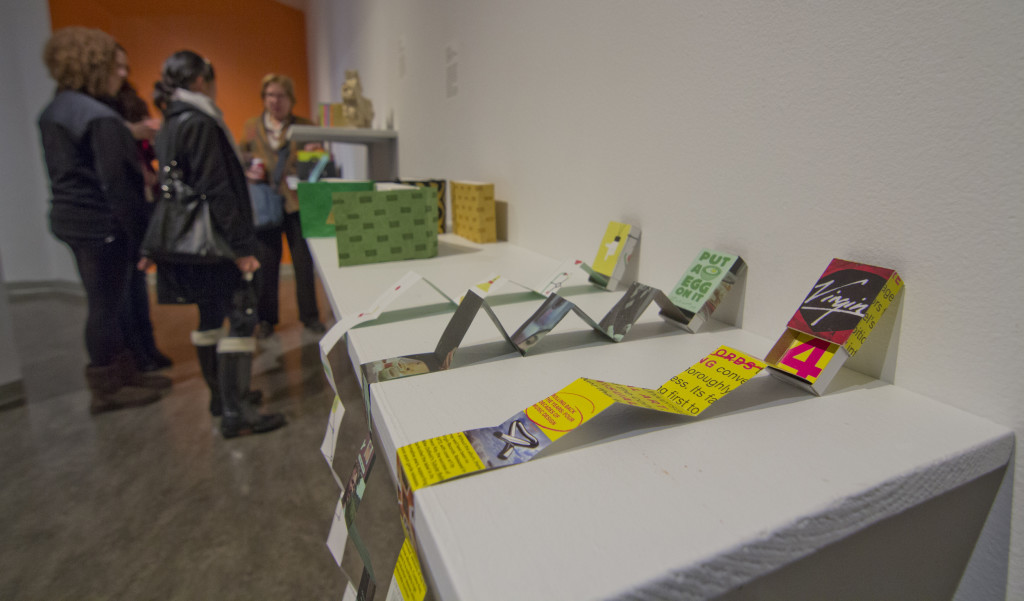The term “book art” might not immediately bring to mind a very versatile art form. Chances are, book covers tend to be the first thing that we might associate with the term, like Francis Cugat’s disembodied eyes staring out of our high school copies of “The Great Gatsby” or that weird, flaming carousel on most covers of “The Catcher in the Rye.”
What might not come to mind is a piñata made out of the pages of a book or a wooden box with the “Legend of Zelda” triforce inscribed on its surface. Yet, it is art like this that is currently on display in Vachon Gallery.
Last August, 16 students and professor Naomi Kasumi spent four weeks in Siena, Italy learning various techniques, ranging from binding to illuminating manuscripts, in the art of book production. The group also spent several hours every day taking basic Italian classes. Their collected works, which they created both during their time in Siena as well as all of fall quarter, is currently on display in the Vachon Gallery.

Works in the new exhibition show varied forms of student creation, from foldout books with windows to Italian rooftops to pieces that play with the concept of the book itself.
The program began back in 2002 when Kasumi, who has a background in book art that dates back to her own college days, traveled around Europe looking for a possible city that would ignite students’ creative interests. She visited cities in both Germany and Switzerland before settling on Italy, where food had an important role to play in the decision making process.
“Potato, meat, sausage, beer…what else is there?” said Kasumi. “For one week that would be fine, but for four weeks that might get boring. In Italy, I immediately noticed my tummy was happy. And immediately that emotion changes everything. It’s a very interesting phenomenon.”
Kasumi eventually found Siena, a medieval town free of cars and American tourists. Since then, the program has taken place five times, with Kasumi serving as faculty adviser for three of them. According to her, the trip is an excellent opportunity for artistic students to not only travel abroad, but to gain hands-on experience in a new art form.
“Students learn the cultural difference, of course—the history, the beauty. And, of course, the joy of creating a book as a piece of art, instead of simply as something to read,” Kasumi said. “It’s important for them to understand that there is a way for them to create art out of the book form — beyond the book form. And, hopefully, they continue exploring it in their own terms, instead of only taking the suggestion from someone else.”
The pieces in the exhibit are truly something to behold and they certainly achieve Kasumi’s hope of transcending a simple understanding of the book. Students have created networks of sentences from disemboweled physics textbooks, foldout books with windows that open into Italian rooftops, and more abstract pieces that play with the concept of the book itself.
In the center of the room, some of the students’ journals are also on display, which introduces an interesting bit of voyeurism to the show. Next to their thoughts and reflections, students make intriguing sketches of the city streets and the food they ate, which provides a more grounded look at the people behind the art.
Apart from the works they created, students also gained the benefits that come along with any trip abroad. For Ben Mouch and Maya Inose, two Seattle U graphic design students who graduated at the end of the program last year, the trip was a compelling way to round out their college experience.
“It was good to get away. One of the main things was getting out of my head,” said Mouch. “Finishing my college education, needing that time to get away from the job search, now it’s all culminating in this exhibition. It was nice to take the skills we learned in Italy and repurpose them into our own work.”
The trip also introduced them to a new art form that they had never experimented with.
“We had never really seen these crazy art books before. I mean, at least for me, I never really saw this kind of thing,” said Inose. “I became more aware of what people do with the idea of books and really appreciated it.”
Mouch agreed. “It was cool to learn more and more what is becoming an antiquated form of getting ideas across,” he said. “The interaction of being able to present these books, when everything is turning towards a digital interface.”
The show will be running until Jan. 31.








